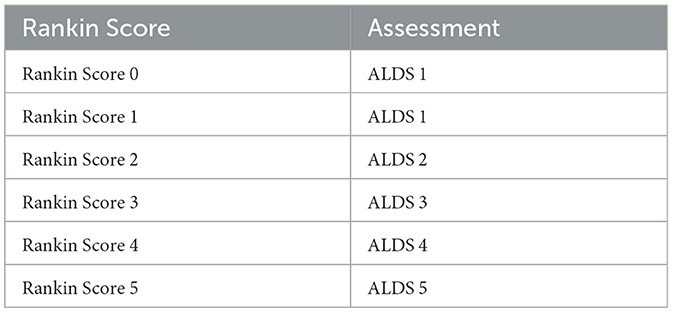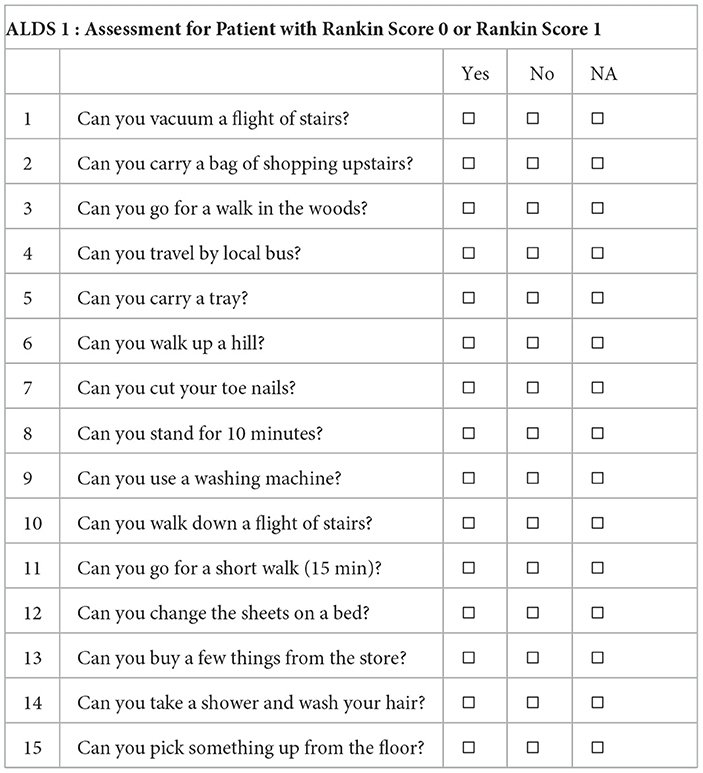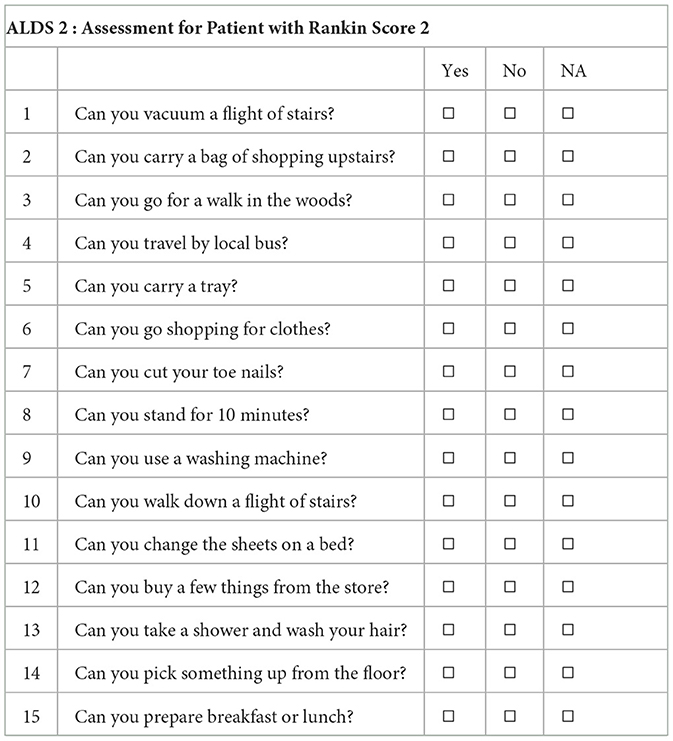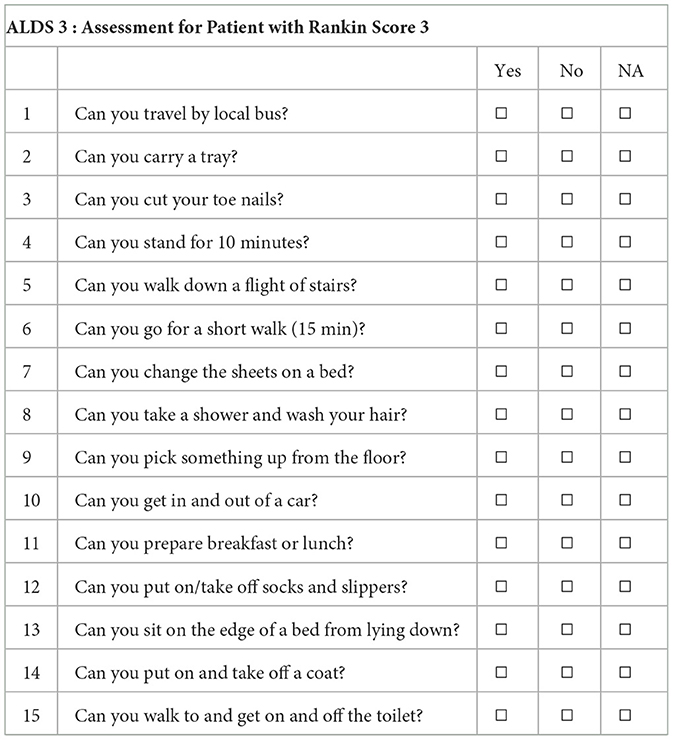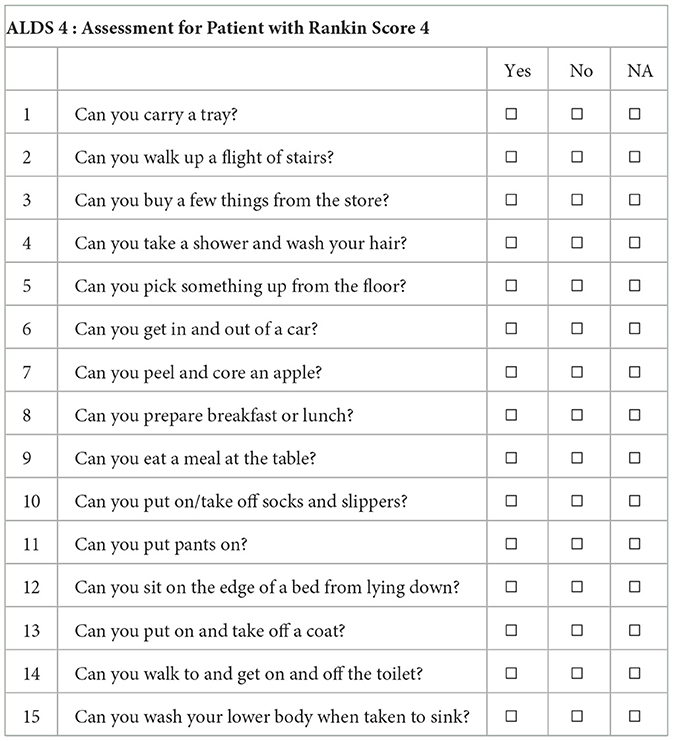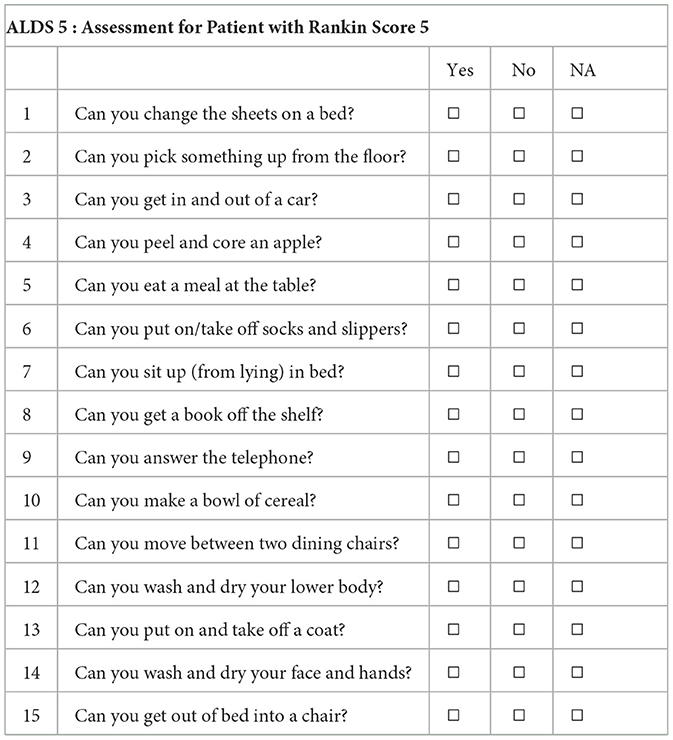- 1Stroke Center, Phyathai 1 Hospital, Bangkok, Thailand
- 2Comprehensive Stroke Center and Departments of Emergency Medicine and Neurology, University of California, Los Angeles, Los Angeles, CA, United States
- 3Department of Biomathematics, University of California, Los Angeles, Los Angeles, CA, United States
- 4Department of Neurology, Stanford University, Palo Alto, CA, United States
- 5Comprehensive Stroke Center and Department of Neurology, University of California, Los Angeles, Los Angeles, CA, United States
- 6National Institutes of Health, Bethesda, MD, United States
- 7Indiana University School of Medicine Department of Neurology, Indianapolis, IN, United States
A corrigendum on
Staged use of ordinal and linear disability scales: a practical approach to granular assessment of acute stroke outcome
by Chaisinanunkul, N., Starkman, S., Gornbein, J., Hamilton, S., Chatfield, F., Conwit, R., and Saver, J. L. (2023). Front. Neurol. 14:1174686. doi: 10.3389/fneur.2023.1174686
In the published article, the Supplementary Methods Text was mistakenly not included in the publication. The missing material appears below:
Supplementary Methods Text
The following 4 pages contain:
1) Administration instructions
2) The 5 ALDS question sets, each containing 15 items indexed to a particular mRS score level
AMC Linear Disability Score (ALDS) after mRS Assessment
Introduction
Assessing the clinically meaningful effect on outcome in stroke patients allows more accurate interpretation in clinical trials. The AMC (Academic Medical Center) Linear Disability Score (ALDS) is a calibrated generic item bank to measure the level of physical disability in patients (1–3). The ALDS is a sensitive and generic disability scale which measures a broader range of activities compare to the Rankin assessment. The major difference between the ALDS and the Rankin assessment is that the ALDS is a linear disability score assessment and is a patient-reported outcome whereas the Rankin score is an ordinal disability score assessment and is a rater-assigned outcome.
General instructions
Sources of information
Obtain information from the same people that provided answers for the Rankin Focused Assessment (RFA).
Choose the right assessment
This assessment is intended for use after completing the Rankin Focused Assessment (RFA). There are different sets of questions matched to each Rankin score result. Choose the AMC Linear Disability Score (ALDS) question set according to the Rankin score. For example, if your patient has Rankin score of 3, then assess ALDS 3 question set. However, if every question in the initial ALDS question set ends up marked ‘Yes' or ‘NA', then please proceed to next lower numbered ALDS question set and complete the assessment unique to that ALDS set. For example, if your patient has a Rankin score of 2, then assess ALDS 2. However, if the patient answered all the questions in ALDS 2 ‘Yes' or ‘NA' then proceed to ALDS 1 and assess all the unique questions in ALDS 1 that were not in ALDS 2. Similarly, if every question in the initial ALDS question set ends up marked ‘No' or ‘NA', then please proceed to next higher numbered ALDS question set and complete the assessment unique to that ALDS set. For example, if your patient has a Rankin score of 2, then you will complete ALDS 2. If the patient answered all questions in ALDS 2 ‘No' or ‘NA' then proceed to ALDS 3 and complete all the unique questions in ALDS 3.
Scoring instructions
There are two response options which are ‘Yes' and ‘No'. If a patient responds that he/she can carry out the activity but only with difficulty, then ‘Yes' should be marked. If a patient says the question is not applicable because the patient has never attempted the activity in the question after stroke, then mark the ‘NA' box. The answer should reflect what the patient can do without assistance of another person. However, assistance of a walker, cane and other prosthetic devices are fine.
References
1. Holman R, Lindeboom R, Glas C, Vermeulen M, de Haan RJ. Constructing an item bank using item response theory: the AMC linear disability score project. Health Serv Outcomes Res Methodol. (2003) 4:19–33.
2. Holman R, Lindeboom R, Vermeulen M, de Haan RJ. The AMC Linear Disability Score project in a population requiring residential care: psychometric properties. Health Qual Life Outcomes. (2004) 2:42. doi: 10.1186/1477-7525-2-42
3. Weisscher N, Vermeulen M, Roos YB, de Haan RJ. What should be defined as good outcome in stroke trials; a modified Rankin score of 0-1 or 0-2? J Neurol. (2008) 255:867–74.
Visit Nurse Name : _______________________________________________
Patient Number : _________ Subject Initials : ___ ___ ___ Date of Visit :___/ ___/ ___
AMC Linear Disability Score Rating Form
Information for completing this form was obtained from (please check all that apply):
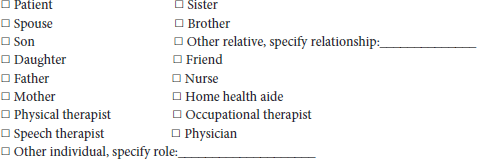
Please mark (X) in the appropriate box. Choose the questionnaire according to the Rankin Score. Please assess all the questions. See the instruction sheets for further information.
Visit Nurse Name : _______________________________________________
Patient Number : _________ Subject Initials : ___ ___ ___ Date of Visit :___/ ___/ ___
Please mark (X) in the appropriate box. Choose the questionnaire according to the Rankin Score. Please assess all the questions. See the instruction sheets for further information.
Visit Nurse Name : _______________________________________________
Patient Number : _________ Subject Initials : ___ ___ ___ Date of Visit :___/ ___/ ___
Please mark (X) in the appropriate box. Choose the questionnaire according to the Rankin Score. Please assess all the questions. See the instruction sheets for further information.
The authors apologize for this error and state that this does not change the scientific conclusions of the article in any way. The original article has been updated.
Publisher's note
All claims expressed in this article are solely those of the authors and do not necessarily represent those of their affiliated organizations, or those of the publisher, the editors and the reviewers. Any product that may be evaluated in this article, or claim that may be made by its manufacturer, is not guaranteed or endorsed by the publisher.
Keywords: cerebrovascular disease/stroke, acute cerebral hemorrhage, acute cerebral infarction, acute stroke syndromes, emergency treatment of stroke, outcome assessment, clinical trials
Citation: Chaisinanunkul N, Starkman S, Gornbein J, Hamilton S, Chatfield F, Conwit R and Saver JL (2023) Corrigendum: Staged use of ordinal and linear disability scales: a practical approach to granular assessment of acute stroke outcome. Front. Neurol. 14:1331276. doi: 10.3389/fneur.2023.1331276
Received: 31 October 2023; Accepted: 06 November 2023;
Published: 12 December 2023.
Edited and reviewed by: Nishant K. Mishra, Yale University, United States
Copyright © 2023 Chaisinanunkul, Starkman, Gornbein, Hamilton, Chatfield, Conwit and Saver. This is an open-access article distributed under the terms of the Creative Commons Attribution License (CC BY). The use, distribution or reproduction in other forums is permitted, provided the original author(s) and the copyright owner(s) are credited and that the original publication in this journal is cited, in accordance with accepted academic practice. No use, distribution or reproduction is permitted which does not comply with these terms.
*Correspondence: Jeffrey L. Saver, anNhdmVyQG1lZG5ldC51Y2xhLmVkdQ==
 Napasri Chaisinanunkul1
Napasri Chaisinanunkul1 Jeffrey Gornbein
Jeffrey Gornbein Scott Hamilton
Scott Hamilton Fiona Chatfield
Fiona Chatfield Jeffrey L. Saver
Jeffrey L. Saver